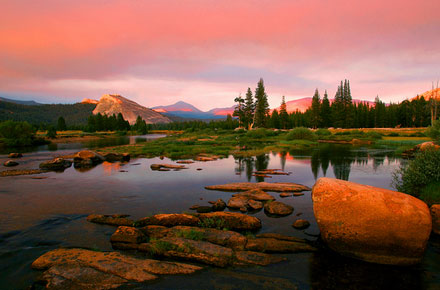If you’ve never been to Tuolumne Meadows then you’re missing out on one of the best parts of Yosemite, in my opinion. It’s a broad, grassy valley surrounded by sharp, knife-edged peaks and domes that makes for some very beautiful scenery. But it’s always been a bit of a mystery how the meadow and the unique mix of geological features surrounding it formed. Now researchers think they may have uncovered clues to how the meadow formed and likely it has to do with the way the Sierra Nevada itself formed.
LiveScience.com. When ice age glaciers carved Yosemite’s distinctive features, flowing ice easily scooped out the shattered granite, leaving only intact rock behind, the researchers think.
The Sierra Nevada mountains are glued together by large masses of cooled magma called plutons. Each pluton was once a blob of rising molten rock that stalled underground and slowly crystallized miles from the surface.
Several plutons form the stunning domes and steep walls of Yosemite National Park, each one overlapping the next, like a pile of sleeping puppies. One of the youngest, called the Cathedral Peak granodiorite, crosses through the Tuolumne Meadows region.
The Cathedral Peak granodiorite was shattered and cracked about 85 million years ago, when new magma pushed upward into the cooling pluton, according to earlier research by Becker’s UW colleagues. Gas or fluids from the younger magma blasted open escape routes in the older granite.
“These volatiles explosively fractured the rock,” said Becker.
The peculiar cracks, called tabular fracture clusters (TFCs), are tightly spaced within Tuolumne Meadows and few and far between elsewhere. The clusters are zones of intensely fractured rock about 3 feet to 320 feet long (3 to 100 meters), with at least four cracks within a 4-inch (10 centimeters) span. The researchers say the valley’s vanished rock was likely pulverized, too. Clumps of clusters plunge toward the meadows on rocky slopes bordering the valley. “When we go to higher elevations, we see TFCs heading straight for the valley air, so we infer that the ghost rocks were filled with TFCs as well,” Becker said.


Comments
31 responses to “The Mystery of Tuolumne Meadows”
You should read this. No really, you should. Tuolumne Meadows is awesome. http://t.co/ckhbLa0AIV
RT @THEYosemiteBlog: The Mystery of Tuolumne Meadows http://t.co/bPrQhNwyN7
Vickie Smith liked this on Facebook.
Shaun Brand liked this on Facebook.
The Mystery of Tuolumne Meadows: If you’ve never been to Tuolumne Meadows then you’re missing out on one of the… http://t.co/G2O0RjuJad
Dave Miller liked this on Facebook.
Emily Nash liked this on Facebook.
Visit Stockton liked this on Facebook.
Jack Hsueh liked this on Facebook.
Linda C May liked this on Facebook.
Dave Couch liked this on Facebook.
Diane Richards liked this on Facebook.
Penny Ema liked this on Facebook.
Nina Lee liked this on Facebook.
The best part.
Sherry Austin liked this on Facebook.
Paul Bairn liked this on Facebook.
Janet Farris liked this on Facebook.
John Marquez liked this on Facebook.
Debra Blackburn liked this on Facebook.
Flavio Corà liked this on Facebook.
Kathi Marie liked this on Facebook.
Jordan Badwater Baker liked this on Facebook.
Kirsten Jacobsen liked this on Facebook.
Joshua Smith liked this on Facebook.
Joe Malone liked this on Facebook.
Yosemite Gazette liked this on Facebook.
Marie Chapman liked this on Facebook.
Yosemite Westlake Campground and RV Park liked this on Facebook.
Jim Van Horn liked this on Facebook.
Kara Fazio liked this on Facebook.